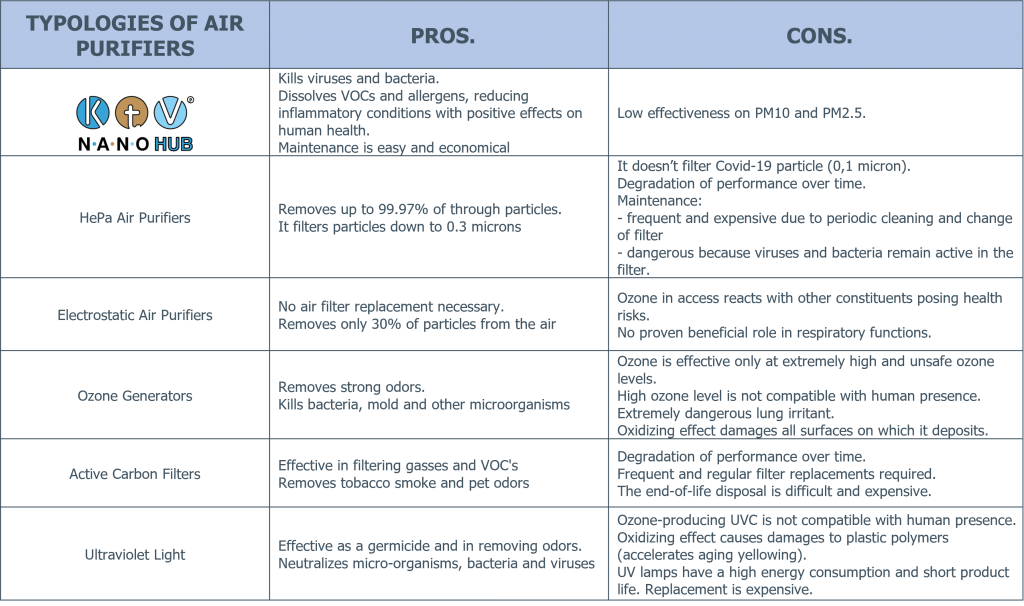FAQ
- On what kind of pollutants is the KtV filter effective?
- Is the photocatalytic process safe for health?
- Do your products need spare parts or consumables?
- Where are your sanitizers produced?
- What guarantee do Nanohub products have?
- My sanitiser is not working properly, who should I contact?
- I need advice on designing a sanitisation system tailored to my needs. Who do I contact?
- How does the design of the customised solution work?
- How does your KtV photocatalytic filter compare with other technologies?
On what kind of pollutants is the KtV filter effective?
The photocatalyst is effective on every harmful substance in the air: bacteria, viruses (tested against Sars-CoV-2), spores, moulds, allergens, cigarette smoke, formaldehyde, benzene, acetaldehyde, fine particulate matter, diethylhexylphthalate (DEHP), dichloro, nitrogen dioxide, mites, toluene, ethylene, trichloroethylene, lead, tetrachloroethylene, Dieldrin, Aldrin, short-chain chlorinated paraffins, carbon monoxide, glycol ethers, endotoxins, phthalates, organotypes, man-made mineral fibres, alkylphenols and organotypes.
Is the photocatalytic process safe for health ?
Our products do not emit anything into the environment, the sanitisation process takes place completely inside the machines, allowing our product range to operate safely even in the presence of humans. Pollutants and toxins are transformed, through the process of photocatalysis, into:
. Sodium nitrate (NaNO3)
. sodium carbonates (Na2CO3)
. limestone (CaCO3)
. carbon dioxide (CO2)
. water vapour
all harmless and measurable in ppb (parts per billion)
Our Photocatalyst is also classified as having a 0 risk of carcinogenicity.
Do your products need spare parts or consumables?
Photocatalysts do not lose their properties over time, as they only act as activators in the process, do not bind to pollutants and remain available for new cycles of photocatalysis. The catalyst does not intervene directly in the reaction, but promotes the photocatalytic reaction by lending its electrons, which it subsequently recovers from the environment.
Our sanitisers, therefore, do not include spare parts and only require periodic cleaning of the dust filter (as per the instructions in the box).
Where are your sanitizers produced?
Our sanitizers are manufactured entirely in Italy.
What guarantee do Nanohub products have?
All Nanohub products are guaranteed for 2 years.
My sanitiser is not working properly, who should I contact?
You should contact your seller.
I need advice on designing a sanitisation system tailored to my needs. Who do I contact?
In the “Contacts” section, you can find all our contact details or you can write to us using the form provided. You will be contacted as soon as possible.
How does the design of the customised solution work?
- First contact
- Customer needs analysis
- Project design
- Proposal and approval
- Real environment testing during project proposal and before customer validation
- Implementation
- Third-party certification
- CTA – Contact per lead
How does your KtV photocatalytic filter compare with other technologies?
Below is a table explaining the main differences among air treatment methods:
